THE HERB GARDEN THEN AND NOW
Plant Life At An 18th-Century Mansion
By Sandy Levins
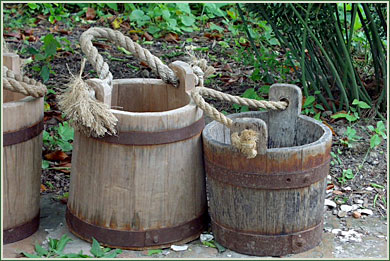
Photo: Hoag Levins
CAMDEN, N.J. -- Tucked away outside the open-hearth kitchen of historic Pomona Hall, the narrow patch of unassuming greenery is easy to miss but rewarding to discover. Bordered with cobblestones, the herb garden provides a living window into the ways of our ancestors as well as an example of how dramatically domestic life has changed since the 18th century.
Once the home of one of the region's richest families, Pomona Hall was the centerpiece of a plantation whose

Photo: Hoag Levins
|
| A portion of the kitchen herb garden at Pomona Hall, the 18th-century mansion maintained by the Camden County Historical Society. Larger photo. | mistress, Mary Cooper, had to provide for her family's daily needs, from foodstuffs to medical treatments. And, standing outside its restored open-hearth kitchen today, many visitors to Pomona Hall can get a good sense of what it must have been like back then.
It's not hard to imagine why. After all, is there anything more pleasing to the senses than an herb garden on a sweet, sultry summer day? The soft breeze catches the evocative, clean scent of lavender. The tang of citrus touched with mint reveals lemon balm, whose small white flowers, like tiny tattered nightshirts, attract the lazy buzzing of bees. The neat, orderly arrangement of each plant, proudly bearing its own nametag -- "sage," "mint," "thyme" -- as it either stretches for the sky or hugs the earth in a loose, sprawling mat, delights the eye and quiets the mind.
Artistic beds
As idyllic as it may sound, Mary Cooper would almost certainly never have sought out the earthly delights of an herb garden like this to while away a lazy summer afternoon. For although the cultivation of special plants for flavoring, dyeing, scenting and dosing is as old as time, their segregation to special beds in specially-designed, artistic layouts is relatively modern.
While it might please us to imagine the herbs once grown at Pomona Hall grouped
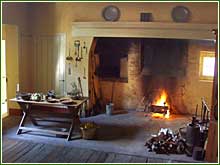
Photo: Hoag Levins
|
| The garden was a direct extension of the kitchen for colonial-era cooks. The Pomona Hall garden is just outside the mansion's open-hearth kitchen. Larger photo. | by their uses -- culinary, medicinal, cosmetic and household -- it is far more likely useful herbs were incorporated into the family vegetable plot. Some thought would have been given to those plants which would thrive year after year (perennials) and those which would require resowing and resetting every year (annuals); big-rooted plants would have been kept away from more delicate plants with shallow roots. Flavored drinks & dosed hogs
Beyond that, the colonial gardener would likely have arranged things so she could put her hand on whatever she needed instantly -- something to staunch bleeding, freshen a drink, flavor a stew or lend a neighbor in childbirth; something, indeed, for a sick hog or cow or an ailing horse. And, considering the prevailing views on cleanliness and personal hygiene, our colonial gardener would surely, from time to time, have reached for a nosegay or handful of "strewing herbs" to freshen the air in her home.
The small herb garden recreated at today's Pomona Hall is an informal, cottage-style garden located just outside the kitchen and planted with an assortment of perennial herbs well-known to the 18th-century gardener: mint, lemon balm, lavender, thyme, yarrow, lovage, lamb's ears, garlic chives, sage, rosemary and santolina -- lavender cotton.
Lore of the early herbalists
Just as any gardener worth her salt would want her household herbs close at hand, no colonial household would be without an herbal -- a reference so important it was often kept, along with a bible, within quick and easy reach. Three herbalists upon whom 17th- and 18th-century gardeners relied were Gerard, Parkinson and Culpeper; of these, Gerard describes herbs with special charm while Culpeper's style is brusque and dogmatic. What, then, did these early botanists have to say about the herbs grown today at Pomona Hall?
Pomona Hall Herbs
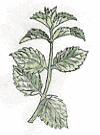 |
Mint (mentha)
Then: Gerard describes mint as "a marvelous wholesome for the stomacke...it stayeth the hicket [hiccup]...is good against watery eyes and a sure remedy for children's sore heads." Parkinson touts mint boiled with "mackerell and other fish" and its use, when dried, "among pease that are boyled for pottage." Culpeper tells us mint would dry up excess milk in nurses and, taken in wine, would help women in childbearing.
And Now: Mint has numerous culinary uses--in sauces, jellies, syrups, teas and drinks. It repels mice and insects. As a health and beauty aid, it is used in skin care products and for oily hair.
|
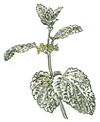 |
Lemon Balm (melissa)
Then: Lemon balm, according to Gerard, is good against "the bitings of venomous beasts." The juice "glueth together" green wounds. Parkinson advises lemon balm steeped in ale against "suddaine qualmes or passions of the heart" while Culpeper notes it will break boils and expel the afterbirth.
And Now: Kitchen uses include teas, wines, liqueurs, vinegars, and in fruit salads and fish dishes. Lemon balm may be added to potpourri and furniture polish. |
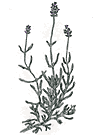 |
Lavender (lavendula)
Then: Gerard found the distilled water of lavender "virtuous," whether it be "smelt unto or the temples and forehead bathed therewith." Parkinson noted lavender's use in perfuming linen, apparel, gloves and leather, while Culpeper found this herb useful for falling sickness or giddiness of the brain.
And Now: Lavender has been baked into cakes, cookies and muffins and used to make jellies, teas and vinegars. In the home, it is added to potpourri and bouquets and used as an insect repellent. |
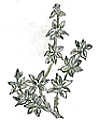 |
Thyme (thymus)
Then: According to Gerard, there was almost nothing thyme could not cure: "It bringeth downe the desired sickness, provoketh urine and applied in bathes it procureth sweat; being boyled in wine it helpeth the ague, stayeth the hicket, breaketh the stones in the bladder; it helpeth lethargie, frensie and madness and stayeth the vomiting of bloud...is good against the wambling and gripings of the bellie, ruptures, convulsions and inflammation of the liver." Culpeper noted that thyme was good for worms, warts, and dull sight.
And Now: Thyme is known as the "blending herb" for its ability to pull flavors together. Cooks use it in salads, stews, soups, sauces, meats, eggs, vegetables and cheeses. In the home, it is a disinfectant and insect repellent. As a health and beauty aid, it may be used for skin care, dandruff and hangovers. |
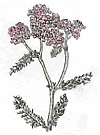 |
Yarrow (achillea)
Then: Yarrow's leaves, according to Gerard, close up wounds and staunch bleeding. The whole plant -- especially the flower heads -- served as a natural dye. Culpeper tells us that a decoction of yarrow, used to bathe the head, "stayeth the shedding of hair."
And Now: In the home and garden, yarrow attracts beneficial insects and speeds composting. |
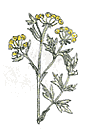 |
Lovage (levisticum)
Then: Gerard found that distilled water of lovage "cleareth the sight and putteth away all spots...freckles...and redness of the face if they be washed therewith."
And Now: Lovage, an old pot herb, is used in salads and salad dressings, soups, stocks, stews, cheeses, sauces and to roast meats. Its celery-like leaves may be added to bouquets. Medicinally, it is a diuretic and useful in treating cramps, urinary tract infections and wounds. |
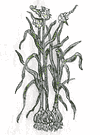 |
Garlic Chives (allium)
Then: Garlic was considered a preservative against pestilential air. Gerard noted it aids women who sit over it in a bath, cures ringworm and scabbed heads. Culpeper found garlic chives good for the falling sickness but bad for those "oppressed with melancholy." He noted that cumin seeds or green beans chewed after eating garlic removed the disagreeable smell from the breath.
And Now: Garlic's use is well known in the kitchen. In the garden, it serves a spray against insects and plant disease. It is thought useful in treating colds and flu, and for blood pressure and cholesterol reduction. |
 |
Sage (salvia)
Then: Gerard found sage "singular good for the head and braine; it quickeneth the senses, strengtheneth the sinewes...and cleanseth the blood." Pakinson touted its use "for teeming women, to helpe them the better forward in their childbearing." Culpeper tells us sage was useful against snakebite and would turn hair black.
And Now: Sage is useful in digesting rich foods. It may be added to vegetables, meats, eggs, breads and vinegars. In the home, it is an antiseptic cleaning solution. |
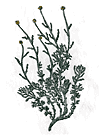 |
Santolina
Then: According to Gerard, lavender cotton "drunke in wine was good against the poysons of all serpents and venomous beasts." Parkinson placed it into "baths, ointments or other things used for cold causes." And Culpepper found it resisted "poison and putrefaction" and was "good against worms ... scabs and itch."
And Now: Today santolina is used most often as an ornamental in knot gardens and as an edging plant. In the home, it may be used in floral arrangements or potpourri and has been found to repel moths. |
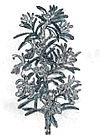 |
Rosemary (rosmarinus)
Then: Gerard tells us that the distilled water of rosemary, drunk morning and evening, "taketh away the stench of the mouth and the breath." Parkinson notes its "civill uses...at weddings, funerals, etc., to bestow among friends." And, according to Culpeper, "to burn the herb in houses and chambers correcteth the air in them."
And Now: In the kitchen, rosemary flavors meats, vegetables, eggs, cheeses and marinades. It may be added to potpourri or used to make an antiseptic cleaning solution. Medicinally, it is used in skin care, as a hair rinse, for sore throat, muscle and joint pain, wounds and bruises. |
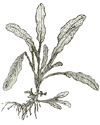 |
Lamb's Ears (stachys byzantina)
Then: Lamb's ears, though little has been written about it, was used to dress or bandage wounds--the wooly leaves used in place of lint. The textured leaves could also be used as a washcloth.
And Now: The silvery lamb's ears may be used in dried arrangements. |
Sandy Levins is a life-long gardening enthusiast and President of the Camden County Historical Society in Camden, NJ.
© All Rights Reserved, HistoricCamdenCounty.com
editor@HistoricCamdenCounty.com
|







